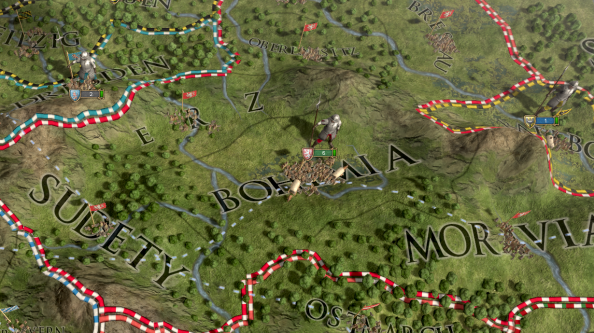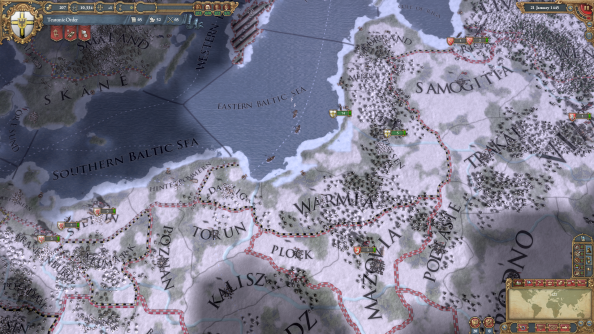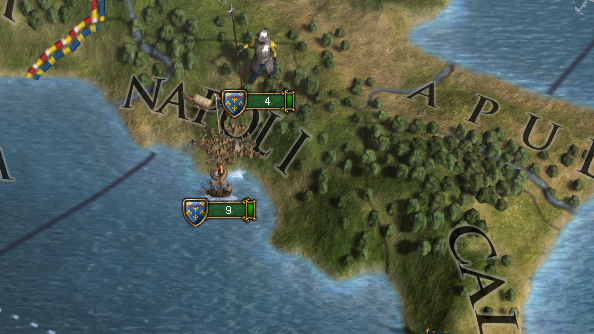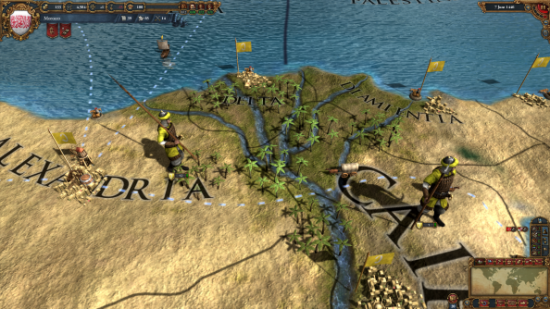The Europa Universalis series represents some of Paradox Development Studio’s most successful and enduring games. Set in the Renaissance era, these hardcore strategy games give players precise control over a historical nation state, allowing them to colonise, trade and, of course, wage war, all in pauseable real-time. They also boast an incredible, almost intimidating depth. The fourth in the series promises over 4,000 historical Monarchs, covers 300 years of history and features 250 different nations. We spoke with PDS about their titanic ambitions, tutorials and tiny development teams.
Creating a sequel to any popular game is difficult, particularly when balancing the desire to add new features with the need to keep things familiar. Surely PDS feel that tension whenever they consider a new feature?
“There’s obviously a certain amount of that tension. People who’ve been through EU I, II and III have the things they love,” says Game Designer Chris King. “Different gamers love different things and no matter what we change, we’re always going to upset someone, and we realise that. What we tried to do was keep the things we loved and enjoyed because we can’t guess what every gamer in the world will like. We went for what we liked and tried to improve things that we felt were weak.”
The latter includes widely-reported issues that players had with Europa Universalis III’s inflation and minting, which could get some gamers into serious (and inescapable) financial trouble. The trade system has also been “completely reworked,” says King, while one of the most significant changes to the game is the introduction of Monarch Points, which determine the strengths of your rulers. Each time your nation crowns (or tiaras) a new ruler, their personality and particular areas of expertise will have a very strong bearing on your policy. While some rulers may be good at making money, others might only be suited to making war, and many a monarch has come or gone at the most inopportune moment: “You can hit this buffer of having an idiot on the throne for twenty years, and all of a sudden you’re starting to fall behind everyone else, and your dominant position is no longer quite so dominant.”
This revolving door of rulers is, of course, historically accurate, but PDS also hope it will keep the game both fresh and challenging, particularly for players who have gained what might otherwise be a comfortable lead and aren’t facing any great challenges. “Once you get big enough, the game is won, why’re you playing?” asks King. “I think it’s a problem that any kind of grand strategy has to wrestle with. How do you keep the challenge going the whole game? We’re always trying to think of things we can do that’ll give players a mid and a late game that’ll be interesting.”
By now, these screenshots of Europa Universalis IV may be looking rather familiar, and that’s because it’s making use of the engine that powers Crusader Kings II, the team’s recent grand strategy hit. It has that same prettier topology, richer depth of colour and smoother animation, but it’s also much neater behind the scenes, being considerably easier for both modders and developers to work with.
“The new engine is way more structured,” says Project Lead Thomas Johansson “It’s easier to make a new map for CKII and EU4 than it was in EU2, for example, because everything had to be hand-drawn and it was very difficult to change something. If a border was in the wrong place, tough! We’ve spent a lot of effort making it easier to work with. Once we’ve taken that initial investment of making an engine, we can spend less time worrying about it. You gain productivity from having a more modern and a more well-thought-through engine to work with.”
This has made it much easier for the team to build much bigger world than any Crusader Kings II players might’ve been used to, literally a world-sized-world, with whole new continents for them to try and conquer, populated by over 250 countries. That said, this increased scope did raise a rather unique problem: “The biggest technical challenge was to get the wrapping effect,” says Johansson. Why? “In EU4 you needed to be able to scroll around the world.” Ah, but of course.
To some, the numbers spread across this world might seem a little dizzying. 4,000 historical Monarchs? Over 250 different countries, all with their own shifting trade concerns, complex economies and scheming rulers? The team make it clear that they aim for longevity, that they want their fans to really bury themselves in these games, but I have to admit that it’s this same sense of size, and all the depth that comes with it, that gives me some reservations. My previous experiences with the series have left me struggling to keep up, even struggling to get started. The plan this time is for those often all too succinct tutorials to be fully developed.
“The problem is we start tutorials too late,” says Johansson. “We have a list chock-full of features and we don’t have enough time to do it all, and at the end of the project we realise we need a tutorial as well.” But he says that helping players to grasp the concepts behind the game is as much a factor of the interface as it is a tutorial, presenting information as and when it’s needed, in easily-digestible chunks.
“We really want to have the information the player needs in the place that he needs it,” he says. “You can give people easy, one-click access to all the important things, and easy access to all the important numbers, and the reaction you get then is people who look at your interface and say ‘Oh my God, look at all these buttons and numbers!’ and then they shut down. You have to show all the information, but you have to be careful not to overload the player.”
Europa Universalis IV is still a year away, but it sounds like PDS are making good progress. As we talk, Studio Manager Johan Andersson explains that the team have been busy with the game since December. I’m surprised to learn that, while other strategy games might boast ever-growing rosters of programmers, designers and artists, all creating more and more assets, the EU team remains a small unit of experienced developers concentrating on core game mechanics, because this is all they feel they need. “When you’ve been doing the same thing for a long time, you get quite good at it,” he says. “And after a certain amount of people, you run into diminishing returns. A perfect group is seven people.”
The studio have decided to remain focused (and, I imagine, frugal) by only employing an additional programmer to work on game engine development, a decision that allows the EU team to remain focused on their work. Time, Andersson says, is the most important factor in their development process, time to iterate, test and refine their game, and attempting to speed up this process would be counter-productive: “Whenever our owners ask ‘Should you get more people on the project? Should you get more money?’ I always say ‘No, we just need more time.’”
